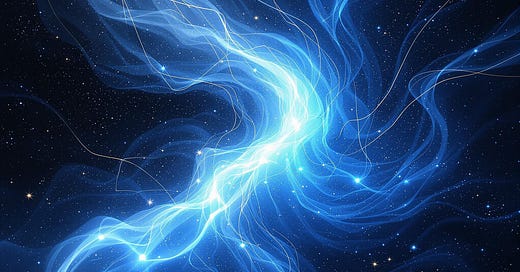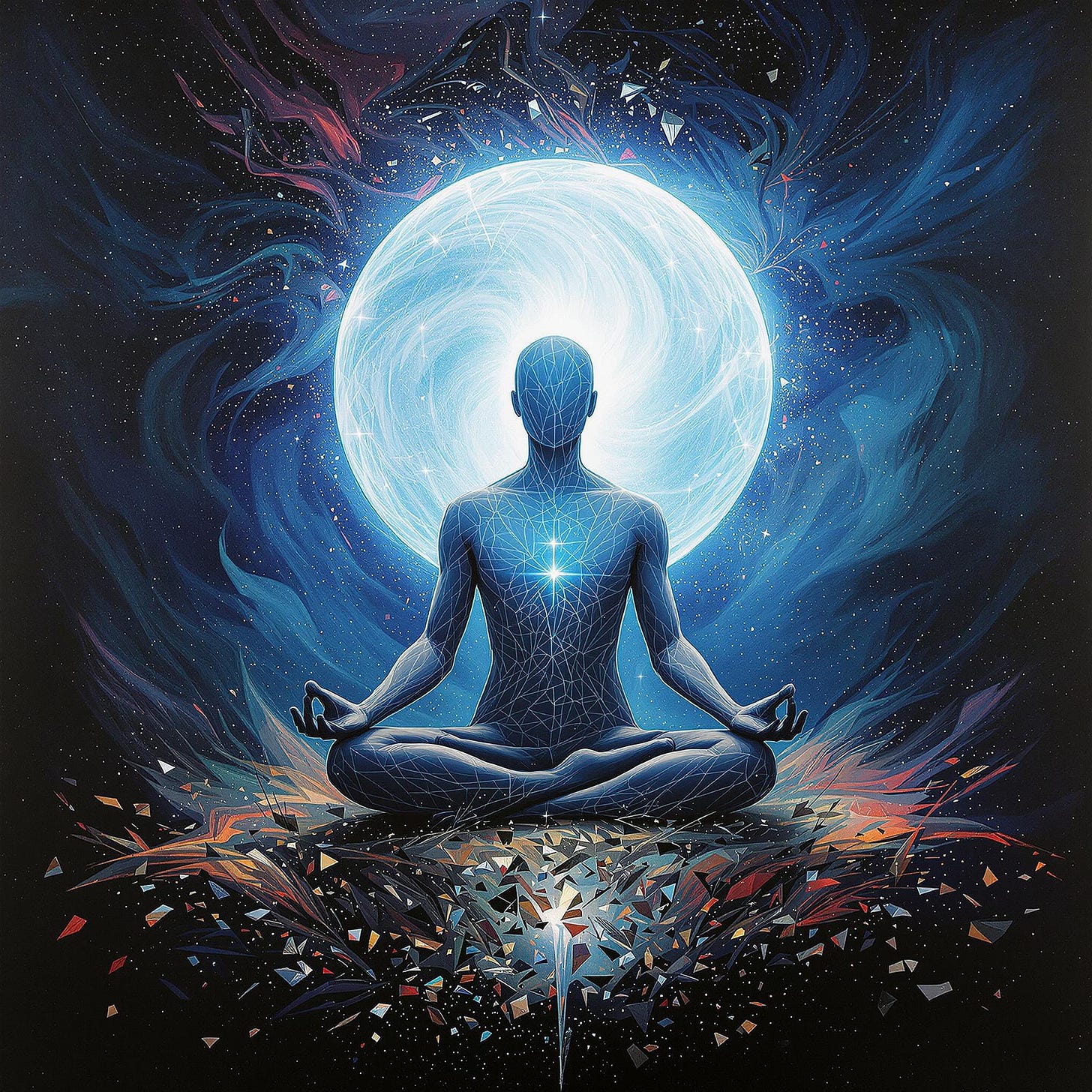I was maybe five? Maybe six? All I know is I was small and totally convinced I could become a Jedi.
Not pretend—actually tap into the Force if I just focused hard enough.
I’d run around the house waving a little stick like it was a lightsaber, whispering lines I had remembered from the movies. Something about it felt so real to me, even then. The Jedi Code, the Light and the Dark, Yoda’s cryptic one-liners—it all felt enormous, but also strangely... personal.
Of course, I didn’t get it at the time. That the path of a Jedi wasn’t really about duels or mind tricks. It was—and still is—about discipline. Awareness. Tuning into something deeper than the self.
Years later, practicing yoga and studying the philosophy behind it, I started to see The Force in a new way.
Star Wars, beneath all the space battles and drama, is speaking to something ancient. Familiar. Ancestral.
There’s this inner tug-of-war we all feel, right? The higher Self pulling one way, the ego pulling another. Dharma versus fear. Intuition versus distraction. It’s the core tension of the Bhagavad Gita—and of Star Wars, too. Will Luke follow the path of his father, Darth Vader? Or will he stay true to the Jedi way? Yogic teachings have explored this kind of internal conflict for thousands of years—and they don’t shy away from the messiness of it all, especially when it’s tangled up with the emotions that come from family, loyalty, and legacy.
And honestly? Sometimes I see B.K.S. Iyengar as a kind of Yoda figure—sharp, uncompromising, deeply wise. Not always warm and fuzzy, but clear. So clear.
And those of us on this path—as Certified Iyengar Yoga Teachers, or just committed students—we’re like Luke. Struggling. Stumbling. Doubting. But still coming back to the mat, again and again, refining our attention, trying to listen more carefully. Feel more fully.
Because like Luke, we don’t get to skip the hard parts. The inner shadows. The resistance.
But we keep going. The practice is the path.
The Force and... Brahman?
That line from Obi-Wan:
“It surrounds us and penetrates us; it binds the galaxy together.”
It’s basically Brahman—the underlying reality, the unchanging energy at the heart of everything.
Of course, Brahman is beyond Light and Dark, while the Force, at least in the films, splits into those sides. But our perception of Brahman gets filtered, clouded by the gunas:
Sattva (clarity)
Rajas (restlessness)
Tamas (inertia)
When a Jedi—or any of us—acts from harmony, that’s a sattvic state. Clear. Aligned. Calm. But when fear or impulse takes over… well, we know how that story goes. It rarely ends well.
In the last yoga workshop I was in, I kept hearing Randy’s voice in my head: “Fear is a reaction. Courage is a decision.” He must’ve said it a dozen times, and it stuck.
Courage, in this sense, feels like the Jedi path. It’s not about being fearless—it’s about being present enough to choose, rather than react. To pause. To act with awareness instead of letting fear drive the ship.
The Jedi Code and the Yamas
The Jedi Code reads like a page torn from Patanjali.
Serenity. Peace. Discipline.
You can line it up right alongside the yamas, the foundational ethics of yoga:
Ahimsa (non-violence): Jedi defend, but don’t attack.
Satya (truth): Trust matters. Lies unravel everything.
Asteya (non-stealing): Not just objects—energy, time, autonomy.
Brahmacharya (moderation): Jedi don’t indulge every craving.
Aparigraha (non-possessiveness): “Fear of loss is a path to the Dark Side,” Yoda reminds us.
It’s not about rules—it’s about alignment. The Jedi don’t use the Force; they serve it.
Same with yoga. My practice isn’t about mastering poses—it’s about becoming more attuned to something beyond myself.
Fear, Attachment... and Anakin
Let’s be honest: Yoda’s most famous line?
“Fear leads to anger. Anger leads to hate. Hate leads to suffering.”
This is a line straight out of the Bhagavad Gita. Actually it’s one of the my favorite versus. (2:62-2:63)
“… Attachment breeds desire, the lust of possession that burns to anger. Anger clouds the judgment; you can no longer learn from past mistakes. Lost is the power to choose between what is wise and unwise, and your life is utter waste.”
Patanjali talks about the kleshas—mental afflictions that cloud clarity:
Avidya (ignorance)
Asmita (ego)
Raga (attachment)
Dvesha (aversion)
Abhinivesha (fear of death/loss)
That’s Anakin’s story, isn’t it?
He doesn’t fall all at once—it’s step by step. Fear becomes craving. Craving turns to rage. And then it’s too late.
But yoga, like the Jedi path, reminds us: we can observe these tendencies. We don’t have to act on them. That’s the work.
Stillness on Dagobah
There’s this scene—Luke, in training with Yoda, standing still, breathing, listening.
It always reminds me of Yoga Sutra 1.2:
yogaś citta-vṛtti-nirodhaḥ
The cessation of the fluctuations of the mind.
That’s the center of the practice.
And the Jedi know it too.
Dhyana. Pranayama. ekagra. These aren’t tricks—they’re tools. Ways to listen beneath the noise.
Most Iyengar Yogis have had glimpses of this in and out of asanas.
And then it’s gone.
But those glimpses—they’re why I keep showing up. The feeling of that encourages you to go deeper and try to understand more.
Choosing Dharma
Both Star Wars and yoga circle around the same question:
Will I act from ego, or from alignment with what’s true?
The Jedi who follow the Light Side? They live in service—not for praise, but for peace.
That’s karma yoga: action without attachment to outcome.
In the Gita, Krishna tells Arjuna:
“You have the right to the action, but not to the fruits of the action.”
“This is the way.” Do the work, not for reward—but because it’s yours to do.
Awakening the Force
So maybe, in the end, Star Wars isn’t just fantasy. It’s a kind of mirror.
Not for the galaxy—but for the inner world. The one we step into every time we are on the mat.
The real battle? It’s always within.
And the real training is subtle. Quiet. Ordinary, even.
That’s where yoga comes in. Not as escape—but as a return. A way back to clarity.
On this May the 4th, practice wholeheartedly.
The Force—or presence, or Brahman, or whatever name feels right—it’s already here.
Just waiting for you to practice.
May the 4th be with you.
—Skyler
P.S.
The Yoga Sutras offer many entry points to stillness. meditate on the chant of aum, this mediate on a realized being, etc. But then there is a sutra - One of my favorites - in BKS Iyengar’s Light on the Yoga Sutras of Patanjali:
“Or, by meditating on any desired object conducive to steadiness of consciousness.”
I love that. It’s a gentle reminder that meditation doesn’t have to look a certain way. It doesn’t always mean sitting perfectly still or chanting Sanskrit.
Sometimes it’s music. Or painting. Or a moment of deep focus when you're fully immersed in something that pulls you inward—something that quiets the noise. That’s meditation, too.
Think about the Beatles in the studio, lost in sound. Or any artist, really, when they slip into that timeless state. That’s the Force. That’s yoga.
So if the thing that steadies your consciousness is a brush, a guitar, a pen, or even a lightsaber (imagined or otherwise)... follow that. It counts.
It’s all part of the path.










Loved this! Just listened to David Lynch's little book on creativity and he cites the Upanishads non-stop. Catching the Big Fish. It's fascinating how so many of our epic stories come back to the earlier epics. Thanks for taking the time to break it all down!
Bravo!